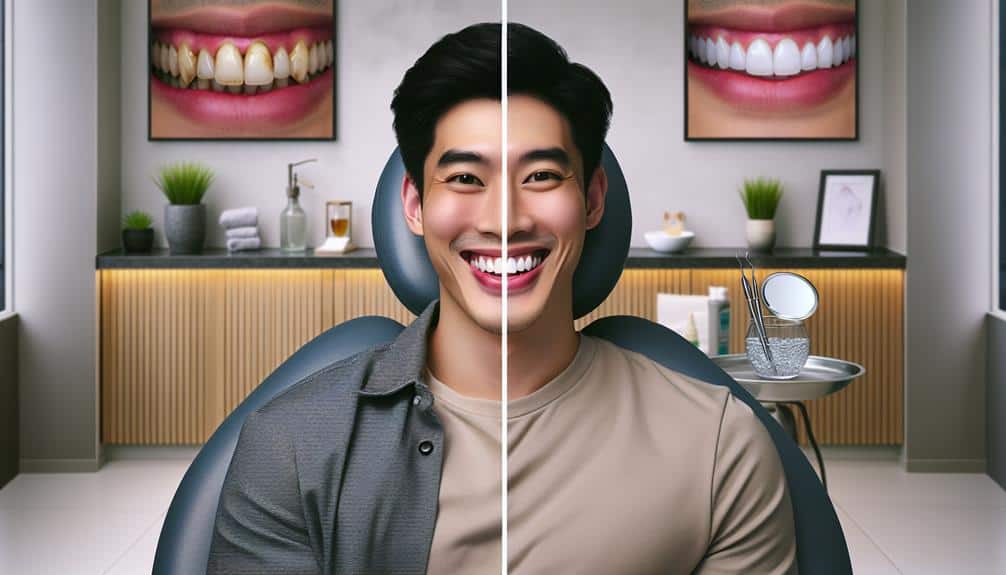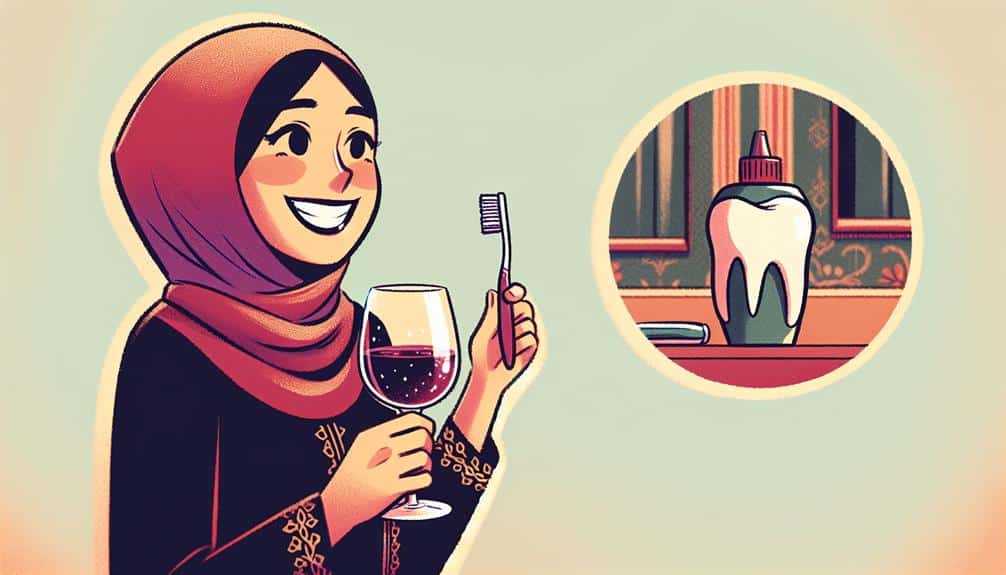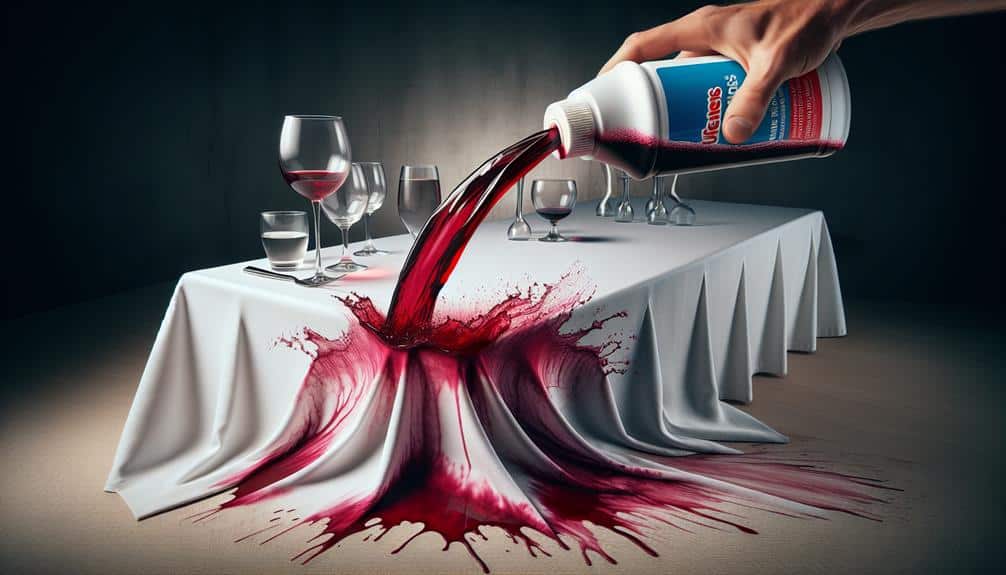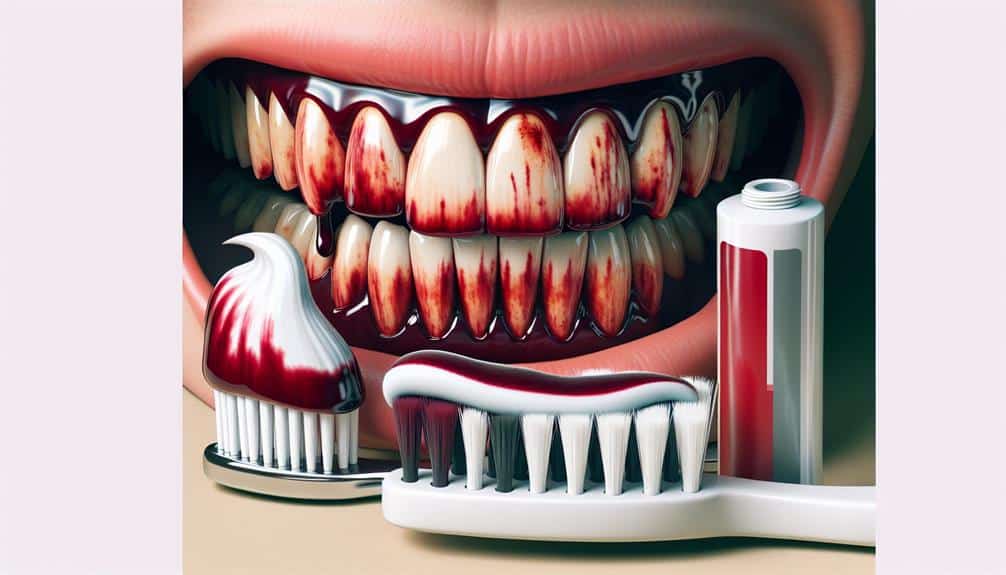If you're looking to combat wine-stained teeth effectively, consider In-Office Professional Whitening, which utilizes specialized techniques and concentrated whitening agents while safeguarding your gums and lips. At-Home Whitening Kits offer custom trays and LED lights for accelerated results with precise application instructions. Whitening Strips with professional-grade gel adhere to teeth, breaking down wine stains for targeted results. Whitening Toothpaste options for enamel protection and sensitivity relief are available, and natural remedies like baking soda and lemon peel provide gentle solutions. Your path to a brighter smile begins with these top professional whitening options.
Key Points
- In-Office Professional Whitening provides specialized techniques and highly concentrated whitening agents for effective wine stain removal.
- At-Home Whitening Kits offer custom trays and LED lights for precise and accelerated whitening treatment.
- Whitening Strips for Wine Stains contain professional-grade gel for targeted whitening and enamel penetration.
- Whitening Toothpaste should focus on enamel protection, sensitivity relief, fluoride content, and gentle formulations.
- Natural Remedies like baking soda, lemon peel, and activated charcoal offer gentle solutions for wine stains.
In-Office Professional Whitening
When you choose in-office professional whitening, a skilled dentist will utilize specialized techniques and highly concentrated whitening agents to effectively eliminate stubborn wine stains from your teeth. Teeth discoloration, especially caused by red wine, can be particularly challenging to address with regular brushing alone. This is where dental procedures like in-office professional whitening play a key role.
During the procedure, the dentist will begin by safeguarding your gums and lips, making sure only your teeth are exposed to the whitening agents. Subsequently, a potent whitening gel is applied to the teeth and activated with a special light to speed up the whitening process. The dentist will carefully oversee the treatment to ensure optimal results while protecting your oral health.
In-office professional whitening is a swift and effective solution for those looking for immediate and noticeable results in combating teeth discoloration from wine stains. The expertise of a trained professional combined with specialized dental procedures makes this option highly effective for achieving a brighter, wine-stain-free smile.
At-Home Whitening Kits
To enhance your understanding of effective teeth whitening methods, consider utilizing At-Home Whitening Kits as a convenient option for addressing wine stains on your teeth. These kits often come with custom trays that allow for a precise and comfortable fit over your teeth, ensuring even whitening coverage. The custom trays help in holding the whitening gel in place, maximizing its contact with the stained areas.
Many At-Home Whitening Kits also incorporate LED lights, which can enhance the whitening process. LED lights are known to accelerate the whitening gel's effectiveness, providing quicker and more noticeable results. The light helps activate the whitening agents in the gel, aiding in breaking down the wine stains on your teeth effectively.
When using At-Home Whitening Kits, follow the instructions carefully to achieve the best results without causing any harm to your teeth or gums. Remember to consult with your dentist before starting any whitening treatment to make sure it's suitable for your dental health.
Whitening Strips for Wine Stains
Consider incorporating professional-grade Whitening Strips into your oral care routine to effectively combat wine stains on your teeth. Whitening Strips are thin, flexible pieces of material coated with a whitening gel containing ingredients like hydrogen peroxide or carbamide peroxide. These strips are designed to adhere to your teeth, allowing the whitening gel to work its magic on the stained areas.
To use Whitening Strips, simply apply them to your teeth according to the instructions provided. The strips are usually worn for a specified amount of time, often around 30 minutes to an hour, allowing the whitening gel to penetrate the enamel and break down the wine stains.
Unlike some at-home remedies, Whitening Strips offer a more controlled application method, ensuring that the whitening gel reaches all areas of your teeth evenly. While they may not be as customizable as dental trays, Whitening Strips are convenient, easy to use, and can be a great option for individuals looking to brighten their smile and combat wine stains effectively.
Whitening Toothpaste Options
To maintain your progress in combating wine stains on your teeth, exploring various Whitening Toothpaste options can enhance your oral care routine effectively. When selecting a whitening toothpaste, consider the following factors:
- Enamel Protection: Look for toothpaste that not only whitens but also provides enamel protection. Ingredients like potassium nitrate or stannous fluoride can help strengthen and protect your enamel while combating stains.
- Sensitivity Relief: If you have sensitive teeth, opt for whitening toothpaste specifically designed to provide relief. These toothpaste variants often contain ingredients like arginine or strontium chloride to help alleviate sensitivity while whitening.
- Fluoride Content: Check the fluoride content in the toothpaste. Fluoride is important for preventing cavities and maintaining overall oral health. Ensure the toothpaste you choose has the recommended amount of fluoride for best protection.
- Avoid Abrasive Ingredients: Be cautious of whitening toothpaste with overly abrasive ingredients like charcoal or baking soda, as they can potentially damage your enamel over time. Opt for gentler formulations to achieve a bright smile without compromising your enamel health.
Natural Remedies for Wine Stains
For those seeking natural solutions to combat wine stains on teeth, exploring homemade remedies can be a beneficial approach. Natural remedies offer a gentle way to address discoloration caused by wine consumption.
One popular DIY solution is baking soda mixed with hydrogen peroxide. This paste can act as a mild abrasive to help lift surface stains without causing damage to the enamel.
Another effective option is rubbing a lemon peel directly on the teeth. The citric acid in the peel can help break down the pigments from wine, although it's crucial to rinse thoroughly afterward to prevent acid erosion.
Activated charcoal is also a trendy choice for tackling wine stains naturally. Its absorbent properties can aid in removing toxins and stains from the teeth. Creating a paste with activated charcoal and water, then brushing gently for a couple of minutes, may help diminish discoloration.
Remember to use these natural remedies sparingly to avoid overuse and potential harm to your tooth enamel.
Frequently Asked Questions
Are There Any Specific Foods or Drinks That Should Be Avoided After Professional Whitening to Prevent Future Wine Stains?
After professional whitening, avoid red wine pairing to maintain your bright smile. Opt for tooth-friendly snacks like cheese and nuts. Refrain from dark beverages and acidic foods that may lead to future wine stains. Drink water to rinse.
How Long Does the Whitening Process Typically Last Before Needing Touch-Ups for Wine-Stained Teeth?
You'll marvel at the endurance of professional whitening, lasting months before requiring touch-ups for those wine-stained teeth. Long-term prevention against wine stains becomes your winning strategy with this whitening durability.
Can Professional Whitening Treatments for Wine-Stained Teeth Cause Sensitivity or Other Side Effects?
After professional whitening for wine-stained teeth, sensitivity can occur. Manage it by using desensitizing toothpaste and avoiding extreme temperatures. Post-treatment care includes regular dental visits and proper oral hygiene. Consider whitening alternatives for long-term maintenance.
Are There Any Alternative Treatments for Wine-Stained Teeth Besides Whitening Products?
When it comes to addressing wine-stained teeth without professional whitening, exploring natural remedies like oil pulling or prevention techniques such as using a straw can be effective. DIY solutions and cosmetic dentistry offer additional options for enhancing your smile.
Are There Specific Dental Hygiene Practices That Can Help Maintain the Results of Professional Whitening for Wine-Stained Teeth?
To maintain professional whitening results for wine-stained teeth, focus on dental hygiene. Use proper flossing techniques, choose toothpaste for whitening, brush thoroughly, and consider mouthwash recommendations. Consistent care guarantees long-lasting effects and a dazzling smile.



